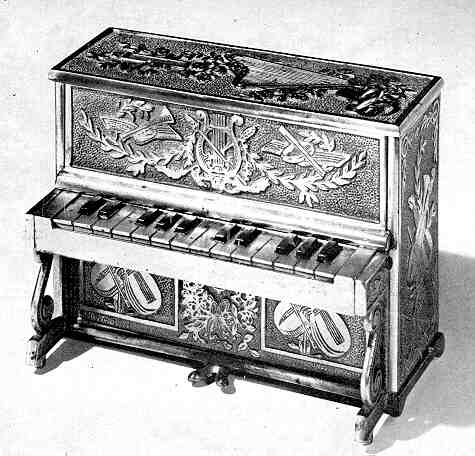Piano Bank
by F.H. Griffith - HOBBIES Magazine - June, 1975

It’s taken a long time but we have finally come up with a Piano Bank that the writer has confidence in as being an authentic, original, mechanical bank — not the usual converted still bank. While at this point it should be further up in the listing, it is now No. 248 in the numerical classification.
The writer has suspected for years that the Piano was originally made both as a still bank and a mechanical bank. It has always been known as a very fine still bank when left in its original state, and it seems a shame that a number of them have been converted to mechanical banks. True, it has not been well done and is somewhat obvious, but why ruin a very good still bank by making it into a fake mechanical. Two reasons, to fool one’s self or to obtain more money for the bank as an authentic mechanical. Not very good reasons to spoil a still bank of any kind, let alone the Piano.
Both the still and the mechanical were made by E. M. Roche Novelty Company, Newark, N.J. This information is cast in raised letters on the underside of the base of the mechanical pictured. Considerable time has been spent on research with respect to the company and the time period. So far, this has been fruitless. Also, no patent papers or old catalogs have been of any help as the writer has found neither one with any reference to the bank. We have not given up as yet and efforts will continue to try to establish definitive information. In any case, the bank has all evidence of being circa 1895 to 1915.
It is not necessary to get into any paint description of the Piano Bank since it is all nickel plated, as is the still. It is necessary to be able to differentiate between the converted still and the genuine mechanical. To begin with, all converted banks seen over the years by the writer have the winding setup on the back of the bank and the musical works under the coin slot, which is in the top. The hole for the winding key, as well as the holes to hold the musical mechanism, are drilled, not cast, into the bank. The setup on the bank shown is quite different, as is the top casting. There is a definite raised cast section for the winding key on top of the bank. The coin slot is to the left in the top and cast this way.
Inside there are various cast lugs on the underside of the top to hold the music mechanism. Lugs are also cast to hold an operating lever that extends from the music unit to the underside of the coin slot. This operating lever activates the mechanism of the musical unit. The lever is spring held and when activated it releases the music unit to play through one time only and then automatically snaps into place stopping the music at the end of the piece. No screws or anything else show on the outside of the bank which would hold the musical unit, as is the case of the converted still bank. It is possible that a converted Piano could have a winding key on top instead of the back, but it would not be in the same fashion as the original described.
The bank shown is in extra nice original condition with the nickel plated finish in fine shape. It was found by that lucky Wally Tudor and is now in his great collection. Score one for Wally, because actually this comes under the heading of a "new find," and that is becoming more and more difficult as time goes on.
To operate the bank it is necessary, of course, first to wind the mechanical unit. Then a coin is pushed into the slot on top of the piano. This causes the inside lever to make about a quarter-turn activating the music element. It plays the piece through and is then ready for another coin.
The back of the piano contains a large, well-constructed coin trap-door having a combination lock and hinges made of brass. The two pedals on the bottom front are also brass. The inside lever is nickel plated brass, as is the winding key. The rest of the bank, other than the musical unit, is cast-iron with nickel finish.
The castings of the various parts of the piano are quite ornate showing a harp, violin, mandolin, horn, and so on. These appear on the top, both sides, and upper and lower part of the front. It is a well-detailed bank and the various musical instruments along with the other decorative effects are cast in rather heavy relief so that they are well defined.
The piece played is Dixie and it plays eight times for eight coins when completely wound.
